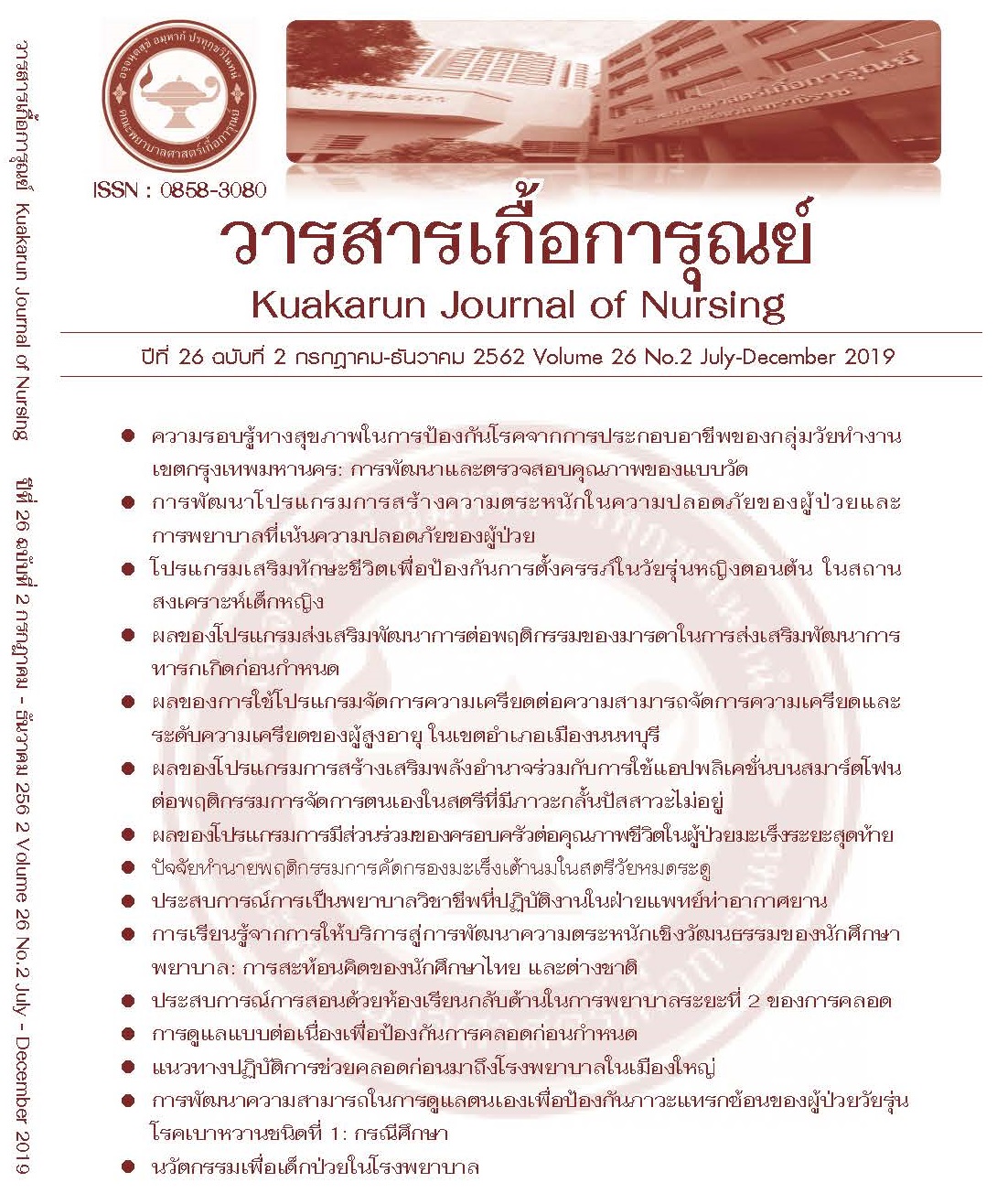The Teaching Experience with Flipped Classroom in Nursing Care during the Second Stage of Labour
Main Article Content
Abstract
Flipped classroom is the teaching methods to respond 21st century learners by learning at home and homework at school, the instructor changes the roles by acting as a facilitator. As nursing care during the second stage of labour is complicated and involves mother and unborn baby, the flipped classroom is applied to teach. Firstly, the instructor created social media technology that helped learners were able to study outside the classroom. Secondly, online discussion via Facebook was also created to communicate to all learners. Finally, classroom activities were based on what learners had learned and questioned Teaching experience on flipped classroom reflected that the instructor should be a facilitator or a coach to assist all learners can improve their critical thinking and learning skills, design activities and preparation of teaching media. Learners had the highest satisfaction scores for the instructor’s aspect (x̄ =4.81 SD=0.39), teaching methods (x̄ =4.47 SD=0.55), and teaching facilities (x̄ =4.30 SD=0.62). Overall, learners’ satisfaction of the flipped classroom showed the highest score (x̄ =4.42 SD=0.53). The implication of using the flipped classroom recommended that the timing of the classroom activities should be longer that included doing mind maps for 45 minutes, group sharing and discussion for one hour, and finalising concept with answering questions for 45 minutes. Information technology should be improved effectively to help all learners engage the database quicker.
Article Details
References
ชนิสรา เมธภัทรหิรัญ. (2560, พฤศจิกายน-ธันวาคม ). ห้องเรียนกลับด้าน (Flipped Classroom) กับการสอนคณิตศาสตร์. ใน ธรชญา พันธุนาวนิช (บรรณาธิการบริหาร), นิตยสาร สสวท, 46(209), 20-22. สืบค้นจาก https://emagazine.ipst.ac.th/209/IPST209/assets/basic-html/page-20.html
ณัฐกานต์ เดียวตระกูล. (2560). การใช้รูปแบบห้องเรียนกลับทางในการจัดการเรียนการสอนภาษาอังกฤษในระดับอุดมศึกษา. ศรีปทุมปริทัศน์ ฉบับมนุษยศาสตร์และสังคมศาสตร์, 17(2), 137-145. สืบค้นจาก
https://sripatum-review.spu.ac.th/doc/51_22-11-2017_11-59-01.pdf
วิจารณ์ พานิช. (2556). ผู้สอนเพื่อศิษย์สร้างห้องเรียนกลับทาง. นนทบุรี: เอส.อาร์.พริ้นติ้ง.แมสโปรดักส์.
ศิริพร พงษ์โภคา, อรนุช เชาว์ปรีชา, ชลดา จันทร์ขาว และพรทิพย์ ชีวะพัฒน์. (บรรณาธิการ). (2552). การพยาบาลมารดาในระยะคลอด. (พิมพ์ครั้งที่ 2). กรุงเทพฯ: วิทยาลัยพยาบาลสภากาชาดไทย.
ศศิธร มุกประดับ, วิภา แซ่เซี้ย, รัดใจ เวชประสิทธิ์ และเนตรนภา คู่พันธวี. (2561). ประสิทธิผลการจัดการเรียนรู้แบบห้องเรียนกลับทางและคุณลักษณะการเรียนรู้แบบชี้นำตนเองของนักศึกษาพยาบาล ชั้นปีที่ 2 ในรายวิชาการพยาบาลผู้ใหญ่และผู้สูงอายุ 1. วารสารพยาบาลสงขลานครินทร์, 38(1), 1-9. สืบค้นจาก https://www.tci-thaijo.org/index.php/nur-su/article/download/117372/90153/
สุรศักดิ์ ปาเฮ. (2556). ห้องเรียนกลับทาง: ห้องเรียนมิติใหม่ในศตวรรษที่ 21. สืบค้นจาก https://www.mbuisc.ac.th/phd/academic/flipped%20classroom2.pdf
Bonwell, C. C., & Eison, J. A. (1991). Active learning: Creating excitement in the classroom.
Retrieved from https://files.eric.ed.gov/fulltext/ED336049.pdf
McMahon, W. (2012). The Flipped Classroom 101. (online). Retrieved from https://www.sharpsville.k12.pa.us/Downloads/edcompass-featurearticle-june2012.pdf

